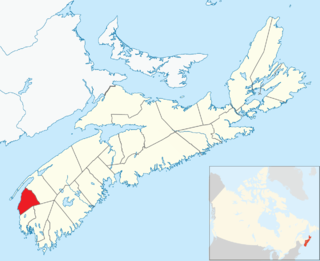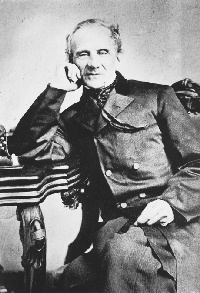
The Technical University of Nova Scotia (TUNS) was a Canadian university located in Halifax, Nova Scotia.

Clare, officially named the Municipality of the District of Clare, is a district municipality in western Nova Scotia, Canada. Statistics Canada classifies the district municipality as a municipal district.
Granville Centre is a rural Canadian community located in Annapolis County on the north shore of the Annapolis River in western Nova Scotia. The community is named after John Carteret, 2nd Earl Granville.

The Musquodoboit River is a Canadian river located in central Nova Scotia in the northeastern part of Halifax Regional Municipality. The river is approximately 97 kilometres (60 mi) in length with roughly 88 kilometres (55 mi) being traversable by paddle. It has a watershed area of 1,409 square kilometres (544 sq mi)

Route 207 is a collector road in the Canadian province of Nova Scotia. It is located in the Halifax Regional Municipality and connects Dartmouth to Porters Lake on the Eastern Shore.
Dollar Lake Provincial Park is a seasonal provincial park located in the Musquodoboit Valley area of the Halifax Regional Municipality in Nova Scotia, Canada, in the community of Wyses Corner, 22 kilometres from the Halifax International Airport on the Old Guysborough Road.
Porters Lake is a rural community in the Eastern Shore region of the Halifax, Nova Scotia, Canada, between Trunk 7 and Route 207, 27.8 km from Halifax. The residents mainly commute to jobs in Dartmouth, Burnside Industrial Park or in Downtown Halifax. The community is built around the lake from which it takes its name.
Nova Scotia Museum (NSM) is the corporate name for the 28 museums across Nova Scotia, Canada, and is part of the province's tourism infrastructure. The organization manages more than 200 historic buildings, living history sites, vessels, and specialized museums and about one million artifacts and specimens, either directly or through a system of co-operative agreements with societies and local boards. The NSM delivers programs, exhibits and products which provide both local residents and tourists in Nova Scotian communities an opportunity to experience and learn about Nova Scotia's social and natural history. More than 600,000 people visit the facilities each year.
Manganese Mines is an unincorporated community in Colchester County, Nova Scotia, Canada.
Lake Egmont is a small rural community in the lower interior of the Musquodoboit Valley, in the Halifax Regional Municipality of Nova Scotia, Canada. Other communities in this area include Antrim and Wyses Corner, Nova Scotia. The community was named after John Perceval, 2nd Earl of Egmont.

Nova Scotia Archives is a governmental archival institution serving the Canadian province of Nova Scotia. The archives acquires, preserves and makes available the province's documentary heritage – recorded information of provincial significance created or accumulated by government and the private sector over the last 300 years.
French Village is a rural community of the Halifax Regional Municipality in the Canadian province of Nova Scotia on Chebucto Peninsula. French village initially included present day villages of Tantallon, Glen Haven and French Village. The French that migrated to the area were French speaking families from the Principality of Montbeliard and known as the "Foreign Protestants". They had come to Nova Scotia between 1750 and 1752 to settle Lunenburg, Nova Scotia. Contrary to belief, they were not Huguenots. The church is the community is St. Paul's Church. In 1901, the Halifax and Southwestern Railway was built through the area and the railway choose the name French Village for the station serving the three communities. The French Village station, actually located in Tantallon, has been preserved as a cafe beside the recreational trail that follows the old Halifax & Southwestern Railway roadbed.
Oldham is a community of the Halifax Regional Municipality in the Canadian province of Nova Scotia. It was named for Oldham in the Greater Manchester area.
Pleasant Point, is a community of the Halifax Regional Municipality in the Canadian province of Nova Scotia.
Oakfield is a community of the Halifax Regional Municipality in the Canadian province of Nova Scotia. The community was founded and named by John Wimburn Laurie. He built St. Margaret's of Scotland Church and is the namesake of Laurie Park. He arrived in Canada in 1861. In 1865 he purchased 800 acres in Oakfield. He brought twenty families from England.
Old Barns is a community in the Canadian province of Nova Scotia, located in Colchester County.
Victoria Beach is a small community in the Canadian province of Nova Scotia, in Annapolis County. It is on the shore of Digby Gut, a narrow channel connecting the Bay of Fundy with the Annapolis Basin.
Castlereagh is a community in the Canadian province of Nova Scotia, located in Colchester County. It was either named after Castlereagh in Northern Ireland or Robert Stewart, Viscount Castlereagh.
There are various Black Lakes in Nova Scotia, Canada. They vary widely in size, depth and usability. Many counties, such as Cumberland, Halifax, Inverness, and Pictou Counties have more than one Black Lake so named, while other counties mentioned in this article have only one named Black Lake.

Hope for Wildlife (HFW) is a non-profit wildlife rehabilitation and education centre located on a farm in Seaforth, Halifax Nova Scotia, Canada. It was founded by Hope Swinimer in 1997 as The Eastern Shore Wildlife Rehabilitation and Rescue Centre. It got its current name in 2005. A television series, Hope for Wildlife, began documenting the centre's efforts in 2009.






